P21-Activated Kinase 1: Emerging biological functions and potential therapeutic targets in Cancer
- PMID: 32863957
- PMCID: PMC7449905
- DOI: 10.7150/thno.46913
P21-Activated Kinase 1: Emerging biological functions and potential therapeutic targets in Cancer
Abstract
The p21-Activated kinase 1 (PAK1), a member of serine-threonine kinases family, was initially identified as an interactor of the Rho GTPases RAC1 and CDC42, which affect a wide range of processes associated with cell motility, survival, metabolism, cell cycle, proliferation, transformation, stress, inflammation, and gene expression. Recently, the PAK1 has emerged as a potential therapeutic target in cancer due to its role in many oncogenic signaling pathways. Many PAK1 inhibitors have been developed as potential preclinical agents for cancer therapy. Here, we provide an overview of essential roles that PAK1 plays in cancer, including its structure and autoactivation mechanism, its crucial function from onset to progression to metastasis, metabolism, immune escape and even drug resistance in cancer; endogenous regulators; and cancer-related pathways. We also summarize the reported PAK1 small-molecule inhibitors based on their structure types and their potential application in cancer. In addition, we provide overviews on current progress and future challenges of PAK1 in cancer, hoping to provide new ideas for the diagnosis and treatment of cancer.
Keywords: PAK1; cancer; resistance; small molecular inhibitors; structure; targets.
© The author(s).
Conflict of interest statement
Competing Interests: The authors have declared that no competing interest exists.
Figures
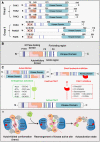

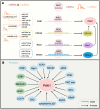

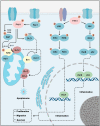

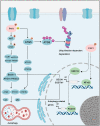
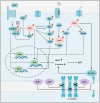

Similar articles
-
Molecular pathways: targeting p21-activated kinase 1 signaling in cancer--opportunities, challenges, and limitations.Clin Cancer Res. 2012 Jul 15;18(14):3743-9. doi: 10.1158/1078-0432.CCR-11-1952. Epub 2012 May 17. Clin Cancer Res. 2012. PMID: 22595609 Free PMC article. Review.
-
Targeting Cdc42 with the small molecule drug AZA197 suppresses primary colon cancer growth and prolongs survival in a preclinical mouse xenograft model by downregulation of PAK1 activity.J Transl Med. 2013 Nov 27;11:295. doi: 10.1186/1479-5876-11-295. J Transl Med. 2013. PMID: 24279335 Free PMC article.
-
Targeting PAK1 with the Small Molecule Drug AK963/40708899 Suppresses Gastric Cancer Cell Proliferation and Invasion by Downregulation of PAK1 Activity and PAK1-Related Signaling Pathways.Anat Rec (Hoboken). 2019 Sep;302(9):1571-1579. doi: 10.1002/ar.24095. Epub 2019 Mar 27. Anat Rec (Hoboken). 2019. PMID: 30773850
-
p21-Activated kinase 1 (PAK1) in aging and longevity: An overview.Ageing Res Rev. 2021 Nov;71:101443. doi: 10.1016/j.arr.2021.101443. Epub 2021 Aug 12. Ageing Res Rev. 2021. PMID: 34390849 Review.
-
Targeting PAK1.Biochem Soc Trans. 2017 Feb 8;45(1):79-88. doi: 10.1042/BST20160134. Biochem Soc Trans. 2017. PMID: 28202661 Free PMC article. Review.
Cited by
-
Targeting Histone Deacetylases 6 in Dual-Target Therapy of Cancer.Pharmaceutics. 2023 Nov 3;15(11):2581. doi: 10.3390/pharmaceutics15112581. Pharmaceutics. 2023. PMID: 38004560 Free PMC article. Review.
-
p21-activated kinase 1 (PAK1) as a therapeutic target for cardiotoxicity.Arch Toxicol. 2022 Dec;96(12):3143-3162. doi: 10.1007/s00204-022-03384-1. Epub 2022 Sep 18. Arch Toxicol. 2022. PMID: 36116095 Review.
-
Butein and Frondoside-A Combination Exhibits Additive Anti-Cancer Effects on Tumor Cell Viability, Colony Growth, and Invasion and Synergism on Endothelial Cell Migration.Int J Mol Sci. 2021 Dec 31;23(1):431. doi: 10.3390/ijms23010431. Int J Mol Sci. 2021. PMID: 35008855 Free PMC article.
-
Neurodevelopmental disorders, like cancer, are connected to impaired chromatin remodelers, PI3K/mTOR, and PAK1-regulated MAPK.Biophys Rev. 2023 Apr 1;15(2):163-181. doi: 10.1007/s12551-023-01054-9. eCollection 2023 Apr. Biophys Rev. 2023. PMID: 37124926 Free PMC article. Review.
-
BACH1 promotes lung adenocarcinoma cell metastasis through transcriptional activation of ITGA2.Cancer Sci. 2023 Sep;114(9):3568-3582. doi: 10.1111/cas.15884. Epub 2023 Jun 13. Cancer Sci. 2023. PMID: 37311571 Free PMC article.
References
Publication types
MeSH terms
Substances
LinkOut - more resources
Full Text Sources
Medical
Research Materials
Miscellaneous

